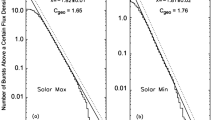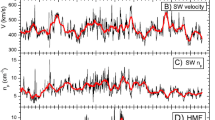Abstract
We present new observational data on the phenomena of extremely high activity on the Sun and in the heliosphere that took place in October–November 2003. A large variety of solar and heliospheric parameters give evidence that the interval under consideration is unique over the entire observation time. Based on these data, comparing them with similar situations in the past and using available theoretical concepts, we discuss possible cause-and-effect connections between the processes observed. The paper includes the first results and conclusions derived by the collaboration “Solar Extreme Events-2003” organized in Russia for detailed investigations of these events. As a result of our consideration, it is beyond question that the physical causes of solar and heliospheric phenomena in October–November 2003 are not exclusively local and do not belong only to the active regions and solar atmosphere above them. The energy reservoirs and driving forces of these processes have a more global nature. In general, they are hidden from an observer, since ultimately their sources lie in the subphotospheric layers of the Sun, where changes that are fast and difficult to predict can sometimes take place (and indeed they do). Solar flares can serve as sufficiently good tracers of these sudden changes and reconstructions on the Sun, although one can still find other diagnostic indicators among the parameters of magnetic fields, motions of matter, and emission characteristics.
Similar content being viewed by others
REFERENCES
Zastenker, G.N., Temnyi, V.V., D'Uston C., and Bosqued J.M., The Form and Energy of the Shock Waves from the Solar Flares of August 2, 4, and 7, J. Geophys. Res., 1978, vol. 83, no. 3, pp. 1035–1041.
Cliver, E.W. and Hudson, H.S., CMEs: How Do the Puz-zle Pieces Fit Together?, J. Atmosph. and Solar-Terr. Phys., 2002, vol. 62, p. 1071.
Romashets, E., Vandas, M., and Nagatsuma, T., Evolution of Geoeffective Disturbances in Interplanetary Space, Proc. Space Weather Workshop: Looking towards a European Space Weather Space Programme, 2003, ESTEC, The Netherlands, pp. 59–62.
Preliminary Report and Forecast of SOLAR-GEO-PHYSICAL DATA, Space Environment Services Center, Boulder, Colorado, USA: SESC PRF, 1991, 823, 824, p.1.
Bothmer, V., Veselovsky, I.S., Dmitriev, A.V., et al., Solar and Heliospheric Reasons for Geomagnetic Pertur-bations during the Growth Phase of the Solar Cycle 23, Solar System Research, 2002, vol. 36, pp. 498–505.
Yermolaev, Yu.I. and Yermolaev, M.Yu., Statistical Rela-tionships between Solar, Interplanetary, and Geomag-netic Disturbances, 1976-2000: 3, Kosm. Issled., 2003, vol. 41, no. 6, pp. 574–584.
Panasyuk, M.I. iet al., Magnetic Storms in October 2003, Kosm. Issled., 2004, vol. 42, Present Issue.
Veselovsky, I.S., Heliospheric Electrojets: Their Struc-ture and Magnetospheric Impacts, Proc. 10th European Solar Physics Meeting, ESA, SP-506, 2002, pp. 37–40.
Zhukov, A.N., Veselovsky, I.S., Clette, F., et al., Solar Wind Disturbances and Their Sources in the EUV Solar Corona, Solar Wind Ten, Velli, M., Bruno, R., and Malara, F., Eds., AIP CP 679, Melville, New York: 2003, pp. 711–717.
Nusinov, A.A., Ionosphere as a Natural Detector for Studying Long-Term Variations in Fluxes of Solar Geo-effective Radiation, Geomagn. Aeron., 2004, vol. 34, no.5 (in press).
Zhitnik, I.A., Bougaenko, O.I., Delaboudiniere, J.-P., et al., SPIRIT X-ray Telescope/Spectroheliometer Results, Proc. of the 10th European Solar Physics Meet-ing, ESA SP, 2002, vol. 506, pp. 915–918.
Oraevskii, V.N. and Sobel'man, I.I., Complex Studies of Solar Activity onboard the Coronas-F Satellite, Pis'ma Astron. Zh., 2002, vol. 28, pp. 457–467.
Chertok, I.M. and Grechnev, V.V., Large-Scale Activity in Eruptive Events of October-November 2003, submit-ted for publication in Astron. Zh., 2004.
Grechnev, V.V., Kuzin, S.V., Slemzin, V.A., and Cher-tok, I.M., Solar Eruptive Events of October-November 2003 by Data of the EUV Complex SPIRIT aboard of the CORONAS-F Satellite, Space Weather, 2004.
Chertok, I.M. and Grechnev, V.V., Large-Scale Cana-lized Dimmings Caused by Coronal Mass Ejections on the Sun, Astron. Zh., 2003, vol. 80, pp. 162–174.
Chertok, I.M. and Grechnev, V.V., Large-Scale Dim-mings Caused by Coronal Mass Ejections on the Sun according to the Data of SOHO/EIT in Four Lines of Extreme UF-Range, Astron. Zh., 2003, vol. 80, pp. 1013–1025.
Bogod, V.M. and Tokhchukova, S.Kh., Specific Features of Microwave Radiation of Active Regions Generating Strong Solar Flares, Pis'ma Astron. Zh., 2003, vol. 29, no. 4, pp. 305–316.
Gorgutsa, R.V., Gnezdilov, A.A., Markeev, A.A., and Sobolev, D.E., An Upgrade of the IZMIRAN's Digital Radio Spectrograph: First Results, Astron. Astrophys. Transactions, 2001, vol. 20, pp. 547–549.
Gorgutsa, R.V., Sobolev, D.E., Fomichev, V.V., and Chertok, I.M., An Eruptive Event with a Fast Drifting Radio Burst of Type II, in Aktivnye protsessy na Solntse i zvezdakh (Active Processes on the Sun in Stars), Sankt-Peterburg: St. Petersb. Gos. Univ., 2002, pp. 28–32.
Chertok, I.M., Fomichev, V.V., Gnezdilov, A.A., et al., Solar Radio Emission in Extreme Events of October-November 2003 by IZMIRAN Data, Space Weather, 2004 (in press).
Thomson, N.R., Rodger, C.J., and Dowden, R.L., Iono-sphere Gives Size of Greatest Solar Flare, Geophys. Res. Lett., 2004, vol. 31.
Kaufmann, P., Raulin, J.-P., Gime®¬nez de Castro, C.G., et al., A New Solar Burst Spectral Component Emitting Only in the Terahertz Range, Astrophys. J., 2004, vol. 603, pp. L121–L124.
Denisov, Yu.I., Kuznetsov, S.N., Logachev, Yu.I., et al., Hard X-ray Emission of Solar Flares in the Second Half of 2001: Preliminary Results of an Experiment with the SPR-N Instrument onboard the Coronas-F Station, Astron. Vestn., 2003, vol. 37, p. 127.
Tindo, I.P., Ivanov, V.D., Mandel'shtam, S.L., et al., Dis-covery of Polarization of X-ray Emission of Solar Flares, Kosm. Issled., 1971, vol. 9, p. 116.
Coburn, W. and Boggs, S.E., Polarization of the Prompt Gamma-Ray Emission from the Gamma-Ray Burst of 6 December 2002, Nature, 2003, vol. 423, p. 415.
Lopez, R.E., Baker, D.N., and Allen, J., Sun Unleashes Halloween Storm, EOS, 2004, vol. 85, no. 11, pp. 105–108.
Mitrofanov, I.G., Litvak, M.L., Kozyrev, A.S., et al., A Search for Water in Martian Soil Using the Data of Global Mapping of Neutron Fluxes Measured by the Rus-sian Instrument HAND onboard the NASA Project 2001 Mars Odyssey, Astron. Vestn., 2003, vol. 37, no. 5, pp.400–412.
Shea, M.A. and Smart, D., A Summary of Major Solar Proton Events, Solar Physics, 1990, vol. 127, pp. 297–320.
Dorman, L.I., Smirnov, V.S., and Tyasto, M.I., Kos-micheskiye luchi v magnitnom pole Zemli (Cosmic Rays in the Earth Magnetic Field), Moscow: Nauka, 1971.
Belov, A.V., Eroshenko, E.A., Oleneva, V.A., et al., What Determines the Magnitude of Forbush Decreases?, Adv. Space Res., 2004, vol. 27, pp. 625–630.
Tsurutani, B.T. et al., The Extreme Magnetic Storm of 1-2 September, 1859, J. Geophys. Res., 2003, vol. 108(A7).
Dvornikov, V.M., Sdobnov, V.E., and Yudina, M.V., Mechanism of Cosmic Ray Modulation by Regular Electromagnetic Fields of the Heliosphere, Astron. Vestn., 2004 (in press).
Dvornikov, V.M. and Sdobnov, V.E., Variations in the Rigidity Spectrum and Anisotropy of Cosmic Rays at the Period of Forbush Effect on the 12-25 July, 1982, Intern. J. Geomagn. Aeron., 2002, vol. 3, no. 3, pp. 217–228.
Debrunner, H., Flueckiger, E., von Mandach, H., and Arens, M., Determination of the Ring Current Radii from Cosmic Ray Neutron Monitor Data for the 17 December 1971 Magnetic Storm, Planet. Space Sci., 1979, vol. 27, pp. 577–581.
Flueckiger, E.O., Smart, D.F., and Shea, M.A., On the Effect of Magnetospheric Current Systems on Cosmic Ray Cutoff Rigidities, Proc. 17th ICRC, Paris, 1981, vol. 4, pp. 244–247.
Baisultanova, L., Belov, A., and Yanke, V., Magneto-spheric Effect of Cosmic Rays within the Different Phases of Magnetic Storms, Proc 24-th ICRC, 1995, vol.4, pp. 1090–1094.
Charakhch'yan, A.N., Investigation of Intensity Fluctua-tions of Cosmic Rays in Stratosphere Caused by Pro-cesses on the Sun, Usp. Fiz. Nauk, 1964, vol. 83, no. 1, pp. 35–62.
Author information
Authors and Affiliations
Rights and permissions
About this article
Cite this article
Veselovsky, I.S., Panasyuk, M.I., Avdyushin, S.I. et al. Solar and Heliospheric Phenomena in October–November 2003: Causes and Effects. Cosmic Research 42, 435–488 (2004). https://doi.org/10.1023/B:COSM.0000046229.24716.02
Issue Date:
DOI: https://doi.org/10.1023/B:COSM.0000046229.24716.02




